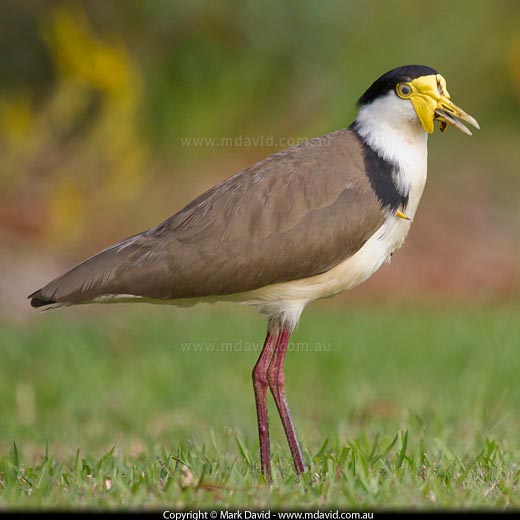
Masked Lapwings. Or are they Spur-winged Plovers?
This is a bird well known for its gutsy behaviour. Whether it be for swooping, its
raucous alarm call or unusual parenting habits, a family of these birds tends to make
an impression. While their reputation is for being anything but timid, I’ve seen
a wonderful gentle side to them.
If you’ve ever been or even known a parent you’ll appreciate that raising
kids is a full-time job. Now imagine that you’re about the size of a football,
and that you tasted like what a fox would call lunch. Also imagine your home is nothing
more than an exposed, windy patch of ground in the middle of a field. If that’s
starting to sound like a tough gig then you’ve got your first glimpse into the
remarkable family life of these birds.
Even as I write this article, I can hear the raucous sound of a pair of nesting
Lapwings nearby. The loud rapid-fire ‘ki-ki-ki-ki-ki’ alarm call, sounding more like
something coming from a small brass instrument than a small feathered animal, lets me know
that someone or perhaps even a dog is wandering past. You’ll hear it a lot if
these birds decide to breed in your area, but before we delve further into matters of
lapwing love, here’s a bit more information about them.
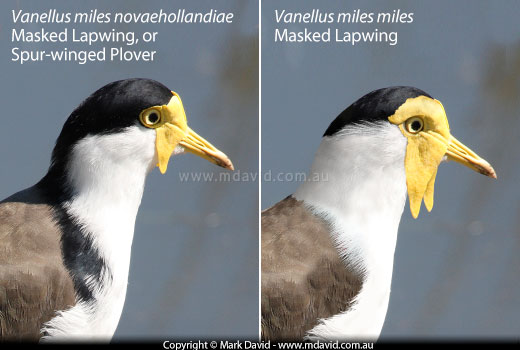
Digitally altered Lapwing: the picture on the right has been manipulated
to show the differences in appearance between the two subspecies.
What’s the deal? Are they lapwings or plovers?
These birds live in Australia, Indonesia, New Guinea, New Caledonia and New Zealand.
In Australia there are two types of the one species, and both can be called Masked Lapwings.
Across the northern parts of the continent there’s a sub-species which scientists
call Vanellus miles miles, and in the southern regions a slightly different
looking critter called Vanellus miles novaehollandiae. It’s that southern
variety which you can also call a Spur-winged Plover.
So you can play it safe and call them all Masked Lapwings, or you can learn to
tell the two sub-species apart, because that’s easy to do. I’ve
digitally manipulated a picture of a Masked Lapwing in the pictures above, to
help. You’ll see that the northern birds have bigger yellow wattles over
their face and no black bands on their shoulders.
By the way, the southern sub-species was the one that managed to find its own way to the
south island of New Zealand and since then it has spread north across the country.
Open spaces
Here’s a prediction: you’ll never hear it said that Masked Lapwings
feel uncomfortable in open spaces. The birds love walking around wide-open areas close
to water, whether they be grasslands, mudflats or beaches, and they seem not to be the
least bit bothered if the area had been cleared naturally or with a mower. In fact
they even feel at home walking around football fields (their colours suggest
they’re Hawthorn supporters). Other places you might see them are on airfields
and even the grassy strips beside busy roads, as they hunt down their diet of
grubs, worms and insects.
Nesting
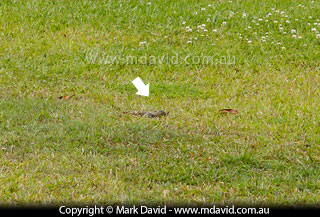
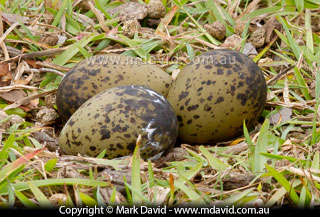
A typical Masked Lapwing nest in the middle of our yard. It was
littered with small objects which enhanced the camouflage effect of the spotty eggs. Most of
the time one of the birds was on the nest, but sometimes both birds would wander off for a
feed. When that happened it was surprisingly difficult to see the eggs until you were right up close to them.
Around late winter and spring, their preference for open spaces becomes even more
surprising, as the birds prepare to breed. While many other species look for a nesting
place offering shelter and concealment — if I was a bird that’s
what I would do — our friends the Masked Lapwings go the other way. They find
a spot that seems to be as exposed as possible. It could be right in the middle of a
playing field, or on top of an empty garden bed. The birds don’t spend time on
elaborate nest construction either — usually it will be just a slight recess
in the ground into which mum lays up to 4 eggs.

One of the parent birds on the nest. The grass is starting to look a bit
messy because I stopped mowing there while all this was going on.
It’s at this point in the story that the Masked Lapwings lose some of their
appeal among people who don’t properly understand their intentions. If you happen
to walk near the nest then chances are you will first be greeted by the birds’
alarm call. Wander even closer and one or both might take off and swoop near you while
filling the air with their high-pitched calls. Some people might call that behaviour
aggressive, but it actually makes sense when you see realise that the birds are only
trying to protect their eggs, which are sitting exposed and vulnerable on the ground.
And most of the time, all that noise and swooping is just bluffing. It’s not
normal for the birds to actually strike people.
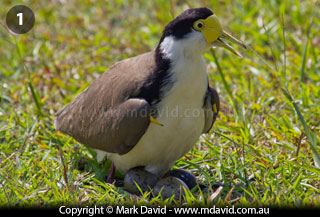

1: One of the parent birds standing over three eggs. 2:
The scene a month later, with two of the chicks hatched that day. Despite being only hours old,
they were already starting to go for short walks around the parent bird. I hadn’t mowed there
for more than a month by that stage!
What do you do if the birds swoop?
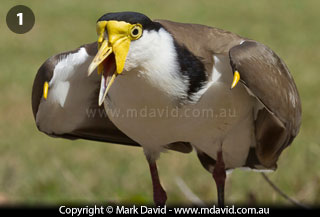
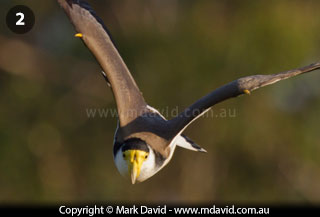
1: One of the parent birds stands its ground near the nest. 2: One
of the parent birds swoops towards me when I walk near
its chicks, in an attempt to drive me out of the area. I don’t deliberately antagonise
wildlife but in this case the birds would swoop me whenever I stepped out my front door (which
is where I took this photo). If this happens to you, tell yourself that the young birds will
be grown up soon and the swooping will then be over.
The most obvious thing is to find a different path to get around the birds. That
might seem like a big imposition at first but usually it’s not such a big deal.
If you must go near them then wearing a hat and eye protection can be a good idea. Travelling
in a group can also encourage the birds to keep their distance. And if you’re
on a bike then you might want to think about dismounting and walking through the area.
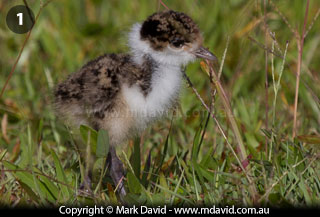
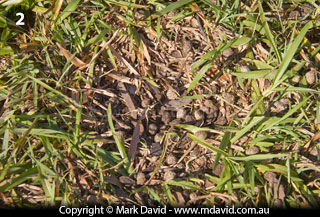
1: One-day-old Masked Lapwing chick. 2: The nesting
site after the birds had moved on. Once all the eggs were hatched the birds didn’t hang around
long. They turned out to be good tenants too — leaving the place as they found it
and not trashing the place! Even the egg shell fragments were gone.
Hatching
Both parents take turns sitting on the eggs and it normally takes about a month for the
eggs to hatch. If you thought the parents had a tough job up until now, the real fun begins
when the chicks emerge. Those young don’t muck around — they’re keen
to get going as soon as possible, which means they are on their feet and exploring within
hours of hatching. In fact you might even notice one or two chicks checking out the
immediate area while their siblings are still in their eggs. During those early days
the chicks are, like the eggs, camouflaged with spots and so it can be quite difficult
to see them until they move.
The chicks are able to feed themselves from day one but in their first weeks they
are covered with soft down and are unable to fly. So once they’ve all hatched
the group starts moving around the local area on foot.
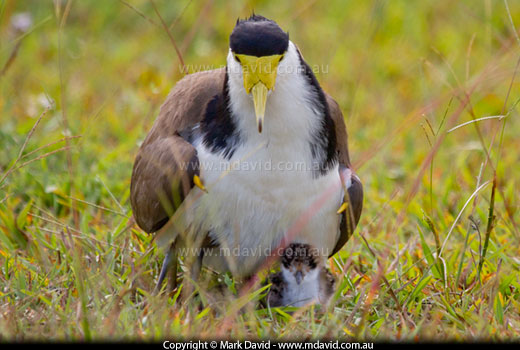
Four birds. Yep, it’s possible to count four birds in this
shot. Hint: one of them wasn’t hatched yet.
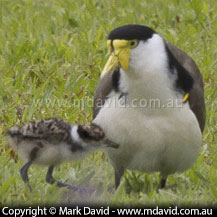
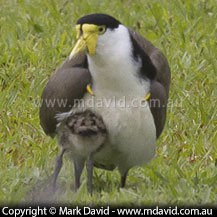
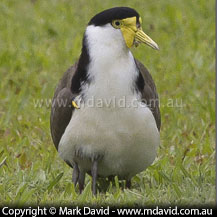
Two birds: A Masked Lapwing chick buries itself
into its parent’s feathers. I’ve seen two chicks hide in the plumage of a single
bird at once and only the presence of a suspiciously large number of legs revealed that anything
was going on.
The parent birds have a full-time job keeping the family together as well as out
of harm’s way. Mum and dad both take an active role and you’ll hear a whole
lot of calls from them at these times too. In fact, it’s likely that you’ll
hear the group approaching long before you see them. That reminds me of some human
families I know but this is a wildlife story so I won’t dwell more on that.
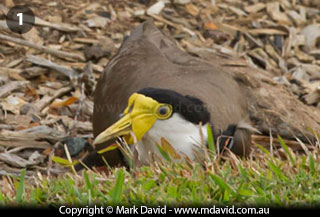
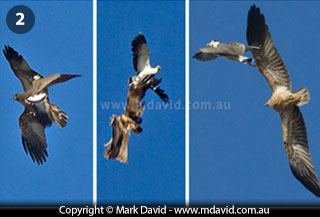
1: One of the parents runs away from its young and drops to the ground
pretending to be injured. This trick is probably meant to lure potential predators away from the
chicks. 2: A Masked Lapwing attacking a Brahminy Kite in the air. The Masked Lapwing
appeared to show no fear of the Kite and some of the attacks were so aggressive that they
resulted in the much larger bird falling tens of metres before regaining control. I don’t
know if that Lapwing was looking after chicks at the time, but the Kite was clearly a potential
predator of young birds
Sneaky bird trick
If something big and scary wanders nearby then the parents jump into action.
First thing you’ll hear is their alarm call, which is the raucous
‘ki-ki-ki-ki’ sound mentioned earlier. There might be a bit of swooping
too, but once again I’ll stress that if you’re not deliberately provoking
the birds then that swooping will probably just be a whole lot of bluffing.
There’s another really smart trick which they often use when a potential
predator comes close. While one parent leads the kids away from danger, the other one
sprints off in the opposite direction and then start limping, and then collapsing
to the ground in a way that suggests it’s been injured. Such a performance is
bound to make it look vulnerable and easy to catch, and so all the more enticing to predators.
It will lie there in a sort of crooked way, appearing
to be unable to escape. If the predator gets closer it then it will then suddenly jump
to its feet and take its act even further from its offpsring. While all this is going on,
the young might be hiding and huddled close to the ground.
When the danger has passed, both parents return to the young and that’s when
you might hear them making another call, which is more like a soft clucking. That seems
to be their way of giving the all-clear. The chicks will return to their family unit
and go back to feeding. Now, if you do ever master the language of Lapwing then I urge
you to resist any temptation that you too might have to run towards the parents at
those times.
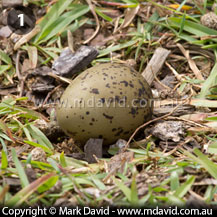
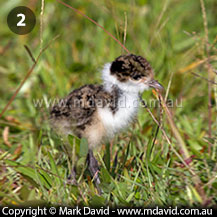
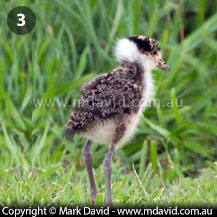
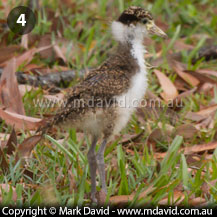

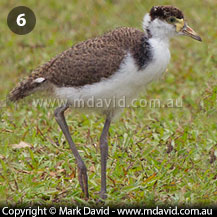
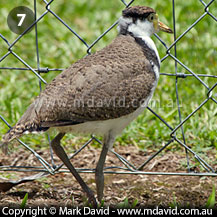
Masked Lapwing chick growing up. 1: Egg 2: one-day-old chick 3: Two weeks after
hatching 4: Three weeks 5: Four weeks 6: Five weeks 7: Six and a half weeks after hatching and
starting to make very short flights (getting a few inches off the ground)
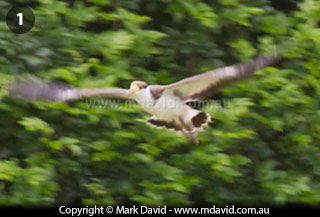
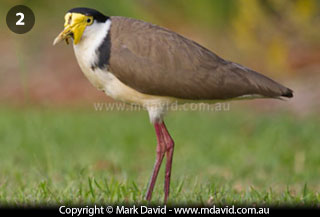
1: Eight weeks after hatching this chick was having no trouble flying 2: Mature Masked Lapwing
Growing up fast
Over the following weeks, the chicks feed themselves under the watchful eyes of
mum and dad. They face a lot of dangers from pets, predators and of course that
well-known arch-enemy of flightless birds crossing roads: the car. In the evenings the family
gathers itself into a more sheltered spot to settle down for the night. In the fading
light this is one of the best times to see some of the more gentle and caring sides of
the parents, providing a huge contrast to all the action happening earlier. You
might even notice a chick or two disappearing almost completely into the warmth of a
parent’s plumage as the larger bird calmly looks on.
About 6 weeks after hatching the chicks will have finally grown some proper feathers,
including wing feathers. They won’t look like spotty balls of fluff on long legs
any more. Instead they will take on the appearance of slightly smaller versions of the
adults. Soon you will be watching the whole family take to the air at the sign of danger.
The parents aren’t ready to kick the kids out just yet though. Chances are that
they will stay together at least until it’s time to breed again the following year.
How long does the swooping last?
If you’ve got a pair of Masked Lapwings swooping you on a regular basis then
you might be wondering how long it’s going to last.
The answer is, they swoop until all the young are able to fly away from danger.
That means about a month while waiting for the eggs to hatch,
and then about another six or seven weeks after hatching, at which point the young have
fledged and are able to fly.
Of course, once the eggs have hatched the family doesn’t hang around the nest area for long,
and so you’ll generally get a bit of a reprieve when they wander around during
the daylight hours to other places for feeding.
A great reward
Putting up with a little bit of commotion over a couple of months is really not a
big deal when the plus side is seeing Masked Lapwings in action. It’s difficult
to watch their parenting without coming away with a genuine admiration for these birds.
When a pair of Lapwings chose our backyard as its nightly sheltering spot
for its young family we consciously chose to give the birds a fair bit of space, and hey, we
didn’t even ask them to pay rent! But the locals tell us those chicks were the first
Masked Lapwings to make it to maturity in this neighbourhood in a long time. The following
year the birds returned, but that time it was to lay their eggs in our yard. It was even
more fun watching the birds that second time around.
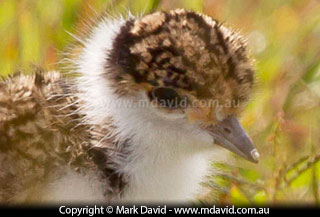
And finally, a few words about the photos on this page
Photographing birds is as much about enjoying the experience as it is about
respecting the wellbeing of your subjects. Being careful not to disturb your
subject is even more important when the birds are breeding.
To get the photos of the breeding birds on this page involved a bunch of
tricks that ensured that they weren’t disturbed. In some instances I was using
a hide. I also noticed that one of the parents was a lot less vigilant than the
other in guarding the eggs, and would sometimes wander off to seek food, leaving
the eggs unguarded. That offered some brief opportunities to get pictures of the nest.
Also, all of the shots were taken with my longest telephoto lens,
allowing me to work from the greatest possible distance.
As much as it’s fun to get a nice shot, it’s a whole lot more enjoyable if the birds
are not frightened away by your behaviour as a photographer. If it ever comes to a
choice between missing out on a shot or disturbing the subjects, then I much
prefer to miss out on getting the shot.
EDIT: A few extra notes about Masked Lapwings breeding
Since I wrote the article above I’ve watched the Masked Lapwings return at least a dozen more times
to nest on our block. We often get more than one brood per season. And I’ve seen a
lot of variation in the parent birds’ behaviour over that time.
The meticulous egg-minding described above has gradually been replaced with a more “casual” style
of parenting, or at least, that’s what happened at our place. The adults birds now
frequently walk off to feed for extended periods, leaving the eggs’ spotty
camouflage to do all the work protecting them. Although the birds didn’t lose their enthusiasm for
swooping me when I stepped outdoors.
In the most recent brood, 3 out of 4 eggs hatched and the parent birds and three chicks walked
off, leaving the 4th egg behind. I watched the chick struggling to emerge from that egg
but left it alone to see if the parent birds would return. Sure enough, one of them did and it
seemed to help the chick out of its shell cage.
I guess the point I’m making here is that the plover parenting you witness might
be different to what I described above. On average, 2 chicks from every brood here
(normally 3 or 4 eggs) survive to maturity so the birds do seem to know what they are
doing. I personally believe in keeping my interference to a minimum. That also means the
grass gets a bit long around their nest until they are finished. But I can live with
that.


Birds

Reptiles

Plants

Insects and spiders

Nature words

Other stuff
Copyright © Mark David. All rights reserved

